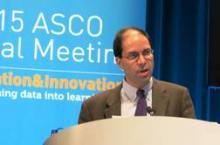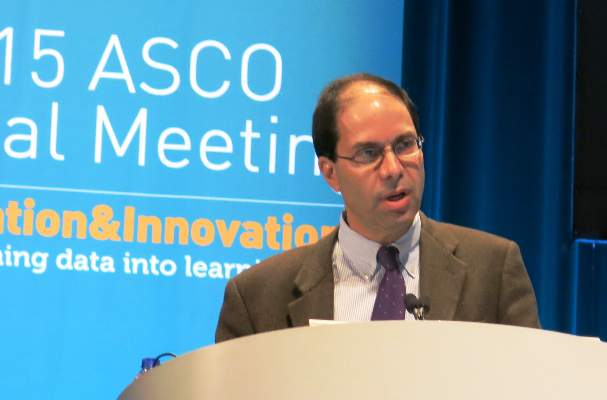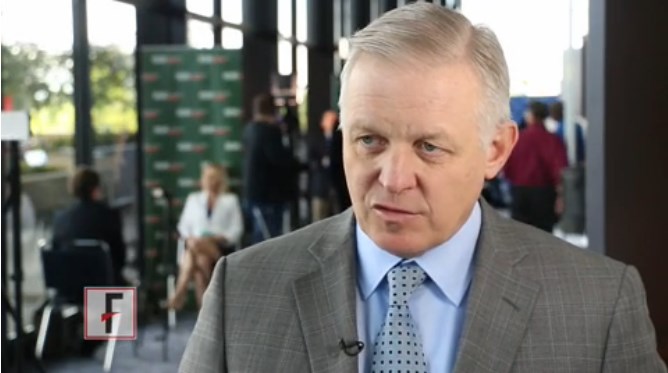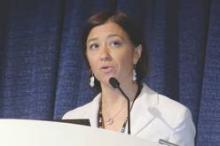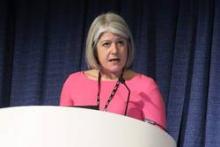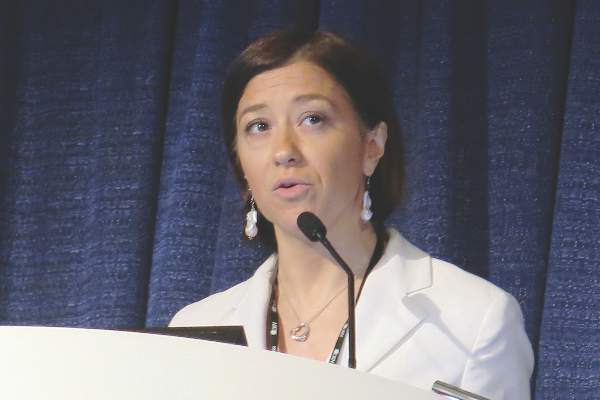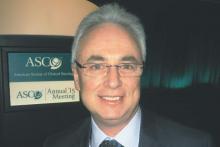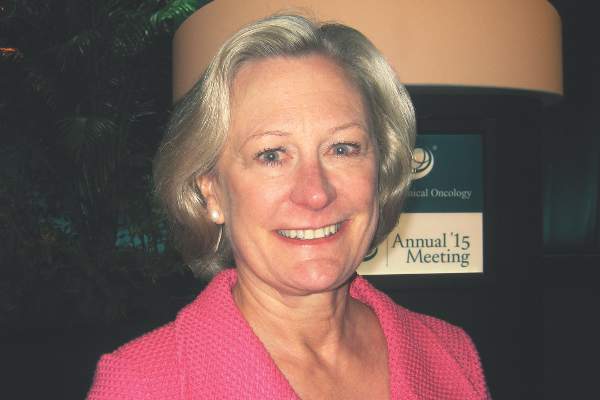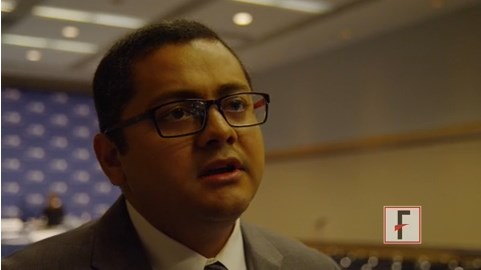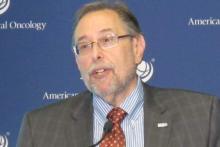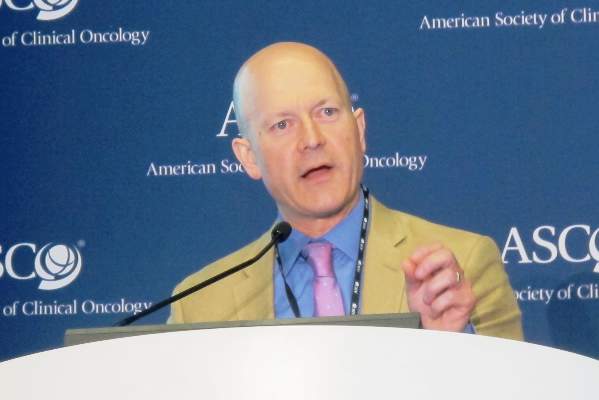User login
American Society of Clinical Oncology (ASCO): Annual Meeting
ASCO: Research IDs new subtype of refractory prostate cancer
CHICAGO – Researchers have identified a new histologic subset of metastatic castration-resistant prostate cancer called intermediate atypical carcinoma.
“Despite being cytologically bland, this is an aggressive cancer with shortened survival similar to that seen with small-cell neuroendocrine cancer,” study author Dr. Eric J. Small said at the annual meeting of the American Society of Clinical Oncology.
Therapies targeting the androgen receptor (AR) like abiraterone and enzalutamide have revolutionized the treatment of metastatic castration-resistant prostate cancer (mCRPC), but resistance to these agents is near-universal and leads to progressive disease and death. At the same time, clinicians are seeing an increasing number of patients with small cell neuroendocrine prostate cancer (SCNC), Dr. Small, professor of medicine at the University of California, San Francisco, said.
As part of a larger project designed to understand the mechanisms of resistance to abiraterone (Zytiga) and enzalutamide (Xtandi) undertaken by the West Coast Prostate Cancer Dream Team, biopsies were performed of a metastatic site in about 160 eligible men with mCRPC.Most (58%) had a Gleason score of 8 or more at diagnosis; 40% had been treated with abiraterone, 10% with enzalutamide, and 17% with both.
Formalin-fixed paraffin-embedded tissue was collected for histologic evaluation by three independent pathologists. Fresh frozen tissue, which underwent laser capture microdissection, was used for genomic analysis.
As of May 1, 173 of 300 planned biopsies have been conducted. In the 160 samples evaluated to date, there was adequate tissue for analysis in 124, for a 78% biopsy success rate, he said.
Among the 124 evaluable biopsies, 35% were classified as pure adenocarcinoma and 13% as pure SCNC.
A novel subtype was identified in another 26% that “consisted of a pure population of cells that was distinct from adenocarcinoma and distinct from small cell neuroendocrine cancer. We have termed this group intermediate atypical carcinoma (IAC),” Dr. Small said.
The remaining quarter of biopsies was composed of mixed populations.
In addition to the independent review, a consensus meeting with two additional pathologists confirmed that this was a new, highly reproducible pathologic subclass, he said.
The researchers next sought to determine whether IAC is phenotypically distinct. A survival analysis was performed based on biopsy pathology and revealed that men who develop IAC have poor survival.
Indeed, survival with IAC (median 11.9 months) tracks with that of SCNC (median 6.6 months) and is distinct from adenocarcinoma, with a log-rank P value of .041, Dr. Small said. Further, when IAC and SCNC were grouped together, there was a dramatically different survival curve (median 8.9 months) than that seen with adenocarcinoma (P = .006).
An analysis using microresected samples indicated that IAC is also genomically distinct, he said. Small cell nuclear clusters showed enrichment of neuronal and cell cycle elements and downregulation of androgen-receptor elements and the immune system.
Based on these findings, machine learning was used to develop a 50-gene signature, with 88.3% accuracy to distinguish small cell from non–small cell histology and 78.5% accuracy to distinguish small cell or IAC histology from adenocarcinoma. The test is not clinically available at this time, but is being used to identify new therapeutic targets.
“We are actively identifying the unique features of this subtype that can be targeted with therapy,” Dr. Small said in an interview. “There is a huge unmet need, since no one knows how to treat these patients, who comprise a significant portion of patients.”
Indeed, in the analysis, IAC represented a fourth of all metastatic castration-resistant biopsies and when combined with small cell neuroendocrine cancer accounted for 40% of all samples.
“This comprises the single largest group of abiraterone- and enzalutamide-refractory patients,” he concluded. “The increasing use of highly potent AR-targeted therapy may contribute to the increasing frequency of this entity, although that is conjecture at this point and certainly ascertainment bias may play a role.”
Discussant Dr. Scott Tomlins, a pathologist from the University of Michigan in Ann Arbor, said one of the study’s major findings is that collecting tissue for comprehensive molecular analysis is feasible in the context of a well-funded, team-based infrastructure, adding that this will likely have to be the way going forward. Despite limited sample numbers, there also appears to be a “strong signal” that gene expression signatures can discriminate various subtypes.
The study was funded by StandUpToCancer, the Prostate Cancer Foundation, and American Association for Cancer Research. Dr. Small reported having no disclosures.
On Twitter @pwendl
CHICAGO – Researchers have identified a new histologic subset of metastatic castration-resistant prostate cancer called intermediate atypical carcinoma.
“Despite being cytologically bland, this is an aggressive cancer with shortened survival similar to that seen with small-cell neuroendocrine cancer,” study author Dr. Eric J. Small said at the annual meeting of the American Society of Clinical Oncology.
Therapies targeting the androgen receptor (AR) like abiraterone and enzalutamide have revolutionized the treatment of metastatic castration-resistant prostate cancer (mCRPC), but resistance to these agents is near-universal and leads to progressive disease and death. At the same time, clinicians are seeing an increasing number of patients with small cell neuroendocrine prostate cancer (SCNC), Dr. Small, professor of medicine at the University of California, San Francisco, said.
As part of a larger project designed to understand the mechanisms of resistance to abiraterone (Zytiga) and enzalutamide (Xtandi) undertaken by the West Coast Prostate Cancer Dream Team, biopsies were performed of a metastatic site in about 160 eligible men with mCRPC.Most (58%) had a Gleason score of 8 or more at diagnosis; 40% had been treated with abiraterone, 10% with enzalutamide, and 17% with both.
Formalin-fixed paraffin-embedded tissue was collected for histologic evaluation by three independent pathologists. Fresh frozen tissue, which underwent laser capture microdissection, was used for genomic analysis.
As of May 1, 173 of 300 planned biopsies have been conducted. In the 160 samples evaluated to date, there was adequate tissue for analysis in 124, for a 78% biopsy success rate, he said.
Among the 124 evaluable biopsies, 35% were classified as pure adenocarcinoma and 13% as pure SCNC.
A novel subtype was identified in another 26% that “consisted of a pure population of cells that was distinct from adenocarcinoma and distinct from small cell neuroendocrine cancer. We have termed this group intermediate atypical carcinoma (IAC),” Dr. Small said.
The remaining quarter of biopsies was composed of mixed populations.
In addition to the independent review, a consensus meeting with two additional pathologists confirmed that this was a new, highly reproducible pathologic subclass, he said.
The researchers next sought to determine whether IAC is phenotypically distinct. A survival analysis was performed based on biopsy pathology and revealed that men who develop IAC have poor survival.
Indeed, survival with IAC (median 11.9 months) tracks with that of SCNC (median 6.6 months) and is distinct from adenocarcinoma, with a log-rank P value of .041, Dr. Small said. Further, when IAC and SCNC were grouped together, there was a dramatically different survival curve (median 8.9 months) than that seen with adenocarcinoma (P = .006).
An analysis using microresected samples indicated that IAC is also genomically distinct, he said. Small cell nuclear clusters showed enrichment of neuronal and cell cycle elements and downregulation of androgen-receptor elements and the immune system.
Based on these findings, machine learning was used to develop a 50-gene signature, with 88.3% accuracy to distinguish small cell from non–small cell histology and 78.5% accuracy to distinguish small cell or IAC histology from adenocarcinoma. The test is not clinically available at this time, but is being used to identify new therapeutic targets.
“We are actively identifying the unique features of this subtype that can be targeted with therapy,” Dr. Small said in an interview. “There is a huge unmet need, since no one knows how to treat these patients, who comprise a significant portion of patients.”
Indeed, in the analysis, IAC represented a fourth of all metastatic castration-resistant biopsies and when combined with small cell neuroendocrine cancer accounted for 40% of all samples.
“This comprises the single largest group of abiraterone- and enzalutamide-refractory patients,” he concluded. “The increasing use of highly potent AR-targeted therapy may contribute to the increasing frequency of this entity, although that is conjecture at this point and certainly ascertainment bias may play a role.”
Discussant Dr. Scott Tomlins, a pathologist from the University of Michigan in Ann Arbor, said one of the study’s major findings is that collecting tissue for comprehensive molecular analysis is feasible in the context of a well-funded, team-based infrastructure, adding that this will likely have to be the way going forward. Despite limited sample numbers, there also appears to be a “strong signal” that gene expression signatures can discriminate various subtypes.
The study was funded by StandUpToCancer, the Prostate Cancer Foundation, and American Association for Cancer Research. Dr. Small reported having no disclosures.
On Twitter @pwendl
CHICAGO – Researchers have identified a new histologic subset of metastatic castration-resistant prostate cancer called intermediate atypical carcinoma.
“Despite being cytologically bland, this is an aggressive cancer with shortened survival similar to that seen with small-cell neuroendocrine cancer,” study author Dr. Eric J. Small said at the annual meeting of the American Society of Clinical Oncology.
Therapies targeting the androgen receptor (AR) like abiraterone and enzalutamide have revolutionized the treatment of metastatic castration-resistant prostate cancer (mCRPC), but resistance to these agents is near-universal and leads to progressive disease and death. At the same time, clinicians are seeing an increasing number of patients with small cell neuroendocrine prostate cancer (SCNC), Dr. Small, professor of medicine at the University of California, San Francisco, said.
As part of a larger project designed to understand the mechanisms of resistance to abiraterone (Zytiga) and enzalutamide (Xtandi) undertaken by the West Coast Prostate Cancer Dream Team, biopsies were performed of a metastatic site in about 160 eligible men with mCRPC.Most (58%) had a Gleason score of 8 or more at diagnosis; 40% had been treated with abiraterone, 10% with enzalutamide, and 17% with both.
Formalin-fixed paraffin-embedded tissue was collected for histologic evaluation by three independent pathologists. Fresh frozen tissue, which underwent laser capture microdissection, was used for genomic analysis.
As of May 1, 173 of 300 planned biopsies have been conducted. In the 160 samples evaluated to date, there was adequate tissue for analysis in 124, for a 78% biopsy success rate, he said.
Among the 124 evaluable biopsies, 35% were classified as pure adenocarcinoma and 13% as pure SCNC.
A novel subtype was identified in another 26% that “consisted of a pure population of cells that was distinct from adenocarcinoma and distinct from small cell neuroendocrine cancer. We have termed this group intermediate atypical carcinoma (IAC),” Dr. Small said.
The remaining quarter of biopsies was composed of mixed populations.
In addition to the independent review, a consensus meeting with two additional pathologists confirmed that this was a new, highly reproducible pathologic subclass, he said.
The researchers next sought to determine whether IAC is phenotypically distinct. A survival analysis was performed based on biopsy pathology and revealed that men who develop IAC have poor survival.
Indeed, survival with IAC (median 11.9 months) tracks with that of SCNC (median 6.6 months) and is distinct from adenocarcinoma, with a log-rank P value of .041, Dr. Small said. Further, when IAC and SCNC were grouped together, there was a dramatically different survival curve (median 8.9 months) than that seen with adenocarcinoma (P = .006).
An analysis using microresected samples indicated that IAC is also genomically distinct, he said. Small cell nuclear clusters showed enrichment of neuronal and cell cycle elements and downregulation of androgen-receptor elements and the immune system.
Based on these findings, machine learning was used to develop a 50-gene signature, with 88.3% accuracy to distinguish small cell from non–small cell histology and 78.5% accuracy to distinguish small cell or IAC histology from adenocarcinoma. The test is not clinically available at this time, but is being used to identify new therapeutic targets.
“We are actively identifying the unique features of this subtype that can be targeted with therapy,” Dr. Small said in an interview. “There is a huge unmet need, since no one knows how to treat these patients, who comprise a significant portion of patients.”
Indeed, in the analysis, IAC represented a fourth of all metastatic castration-resistant biopsies and when combined with small cell neuroendocrine cancer accounted for 40% of all samples.
“This comprises the single largest group of abiraterone- and enzalutamide-refractory patients,” he concluded. “The increasing use of highly potent AR-targeted therapy may contribute to the increasing frequency of this entity, although that is conjecture at this point and certainly ascertainment bias may play a role.”
Discussant Dr. Scott Tomlins, a pathologist from the University of Michigan in Ann Arbor, said one of the study’s major findings is that collecting tissue for comprehensive molecular analysis is feasible in the context of a well-funded, team-based infrastructure, adding that this will likely have to be the way going forward. Despite limited sample numbers, there also appears to be a “strong signal” that gene expression signatures can discriminate various subtypes.
The study was funded by StandUpToCancer, the Prostate Cancer Foundation, and American Association for Cancer Research. Dr. Small reported having no disclosures.
On Twitter @pwendl
AT THE 2015 ASCO ANNUAL MEETING
Key clinical point: Researchers have identified an aggressive new histologic subset of metastatic castration-resistant prostate cancer.
Major finding: Of 124 evaluable biopsies, 35% were pure adenocarcinoma, 13% pure small cell neuroendocrine cancer, and 26% intermediate atypical carcinoma.
Data source: Pathologic and genomic analyses in men with metastatic castration-resistant prostate cancer.
Disclosures: The study was funded by StandUpToCancer, the Prostate Cancer Foundation, and American Association for Cancer Research. Dr. Small reported having no disclosures.
VIDEO: Dr. William J. Gradishar provides take-home messages from ASCO 2015
CHICAGO – Dr. William J. Gradishar says bevacizumab may not be dead, T-DM1 is definitely not dead, and the jury is still out on bisphosphonates preventing recurrence, based on presentations at the annual meeting of the American Society of Clinical Oncology.
In a video interview, Dr. Gradishar, the Betsy Bramsen Professor of Breast Oncology at Northwestern University, Chicago, also outlines results presented on newer agents, including the CKD 4/6 inhibitor palbociclib and neratinib, a pan-HER tyrosine kinase inhibitor.
Dr. Gradishar had no financial disclosures related to these studies.
The video associated with this article is no longer available on this site. Please view all of our videos on the MDedge YouTube channel
On Twitter @nikolaideslaura
CHICAGO – Dr. William J. Gradishar says bevacizumab may not be dead, T-DM1 is definitely not dead, and the jury is still out on bisphosphonates preventing recurrence, based on presentations at the annual meeting of the American Society of Clinical Oncology.
In a video interview, Dr. Gradishar, the Betsy Bramsen Professor of Breast Oncology at Northwestern University, Chicago, also outlines results presented on newer agents, including the CKD 4/6 inhibitor palbociclib and neratinib, a pan-HER tyrosine kinase inhibitor.
Dr. Gradishar had no financial disclosures related to these studies.
The video associated with this article is no longer available on this site. Please view all of our videos on the MDedge YouTube channel
On Twitter @nikolaideslaura
CHICAGO – Dr. William J. Gradishar says bevacizumab may not be dead, T-DM1 is definitely not dead, and the jury is still out on bisphosphonates preventing recurrence, based on presentations at the annual meeting of the American Society of Clinical Oncology.
In a video interview, Dr. Gradishar, the Betsy Bramsen Professor of Breast Oncology at Northwestern University, Chicago, also outlines results presented on newer agents, including the CKD 4/6 inhibitor palbociclib and neratinib, a pan-HER tyrosine kinase inhibitor.
Dr. Gradishar had no financial disclosures related to these studies.
The video associated with this article is no longer available on this site. Please view all of our videos on the MDedge YouTube channel
On Twitter @nikolaideslaura
EXPERT ANALYSIS FROM THE 2015 ASCO ANNUAL MEETING
LSC phenotypes correlate with prognosis in AML

© ASCO/Rodney White
CHICAGO—Researchers say they have identified 3 leukemia stem cell (LSC) phenotypes that are correlated with cytogenetic/molecular abnormalities and prognosis in acute myeloid leukemia (AML).
The investigators believe this knowledge could aid risk stratification of AML patients, particularly those without identifiable cytogenetic or molecular risk factors.
The findings may also pave the way for scientists to identify novel therapeutic targets on LSCs and monitor LSCs in response to therapy.
Jonathan Michael Gerber, MD, of Levine Cancer Institute in Charlotte, North Carolina, presented the findings at the 2015 ASCO Annual Meeting (abstract 7000*).
Via previous research, Dr Gerber and his colleagues identified 3 different LSC phenotypes in AML:
- LSCs that are CD34-negative
- LSCs that are CD34-positive, CD38-negative, and have intermediate levels of aldehyde dehydrogenase (ALDHint)
- LSCs that are CD34-positive, CD38-negative, and have high levels of ALDH (ALDHhigh).
With the current study, the researchers wanted to determine if these phenotypes correlate with cytogenetic/molecular features and treatment outcomes.
So they analyzed diagnostic samples from 98 patients with newly diagnosed AML who had normal or unfavorable cytogenetics. The patients were enrolled on a phase 2 trial comparing FLAM and 7+3 (Zeidner et al, haematologica 2015).
Dr Gerber and his colleagues identified 22 patients with CD34- LSCs, 43 with ALDHint LSCs, and 33 with ALDHhigh LSCs.
Risk factors
“We found that leukemia stem cell phenotype indeed correlated quite strongly with cytogenetic and molecular risk factors,” Dr Gerber said.
NPM1 mutations were more common in patients with CD34- LSCs (64%) than those with ALDHint LSCs (14%) or ALDHhigh LSCs (6%, P<0.001). NPM1 mutations were the sole abnormality in 50% of patients with CD34- LSCs.
Poor-risk cytogenetics and/or FLT3-ITD mutations were more common in patients with ALDHhigh LSCs (85%) than those with ALDHint LCSs (35%) or CD34- LSCs (18%, P<0.001).
Nine percent of patients in the CD34- LSC group fell into the European Leukemia Network poor-risk category, compared to 73% of patients in the ALDHhigh LSC group.
Only 2 patients had 11q23, and both had CD34- LSCs. Fifty-five percent of patients with ALDHhigh LSCs had prior myelodysplastic syndromes or myeloproliferative neoplasms.
Prognosis
“We found that leukemia stem cell phenotype correlated strongly with outcomes as well,” Dr Gerber said. “It turned out that CD34- patients fared more favorably overall.”
Patients with CD34- LSCs had the highest complete response rate (86%), followed by those with ALDHint LSCs (67%) and ALDHhigh LSCs (45%, P<0.01).
Patients in the CD34- group also had a higher rate of event-free survival at 2 years (46%) than patients in the ALDHint group (26%) or the ALDHhigh group (0%). The median event-free survival was 13 months, 11.3 months, and 2.2 months, respectively (P<0.01).
The rate of overall survival at 2 years was best for the CD34- group (76%), followed by the ALDHint group (38%) and the ALDHhigh group (34%). The median overall survival was not reached, 18.7 months, and 9.4 months, respectively (P=0.02).
Dr Gerber also noted that ALDHhigh patients fared much better if they underwent hematopoietic stem cell transplant.
“There is 0% leukemia-free survival at the 2-year mark for the ALDHhigh patients who were not transplanted,” he said. “Those that were transplanted fared about the same as everyone else in the series. So it was very striking that there were no chemotherapy survivors in that group.”
In closing, Dr Gerber said this research suggests the 3 LSC phenotypes are mutually exclusive and correlate with cytogenetic and molecular risk factors as well as outcomes in patients with AML.
“This [discovery] may allow for rapid risk stratification in this explosive disease, facilitate enrollment onto induction protocols . . . , and allow us to divert those ALDHhigh, very high-risk patients earlier to novel therapies and/or transplant, given that they’re not really helped much by conventional chemotherapy.” ![]()
*Information in the abstract differs from that presented at the meeting.

© ASCO/Rodney White
CHICAGO—Researchers say they have identified 3 leukemia stem cell (LSC) phenotypes that are correlated with cytogenetic/molecular abnormalities and prognosis in acute myeloid leukemia (AML).
The investigators believe this knowledge could aid risk stratification of AML patients, particularly those without identifiable cytogenetic or molecular risk factors.
The findings may also pave the way for scientists to identify novel therapeutic targets on LSCs and monitor LSCs in response to therapy.
Jonathan Michael Gerber, MD, of Levine Cancer Institute in Charlotte, North Carolina, presented the findings at the 2015 ASCO Annual Meeting (abstract 7000*).
Via previous research, Dr Gerber and his colleagues identified 3 different LSC phenotypes in AML:
- LSCs that are CD34-negative
- LSCs that are CD34-positive, CD38-negative, and have intermediate levels of aldehyde dehydrogenase (ALDHint)
- LSCs that are CD34-positive, CD38-negative, and have high levels of ALDH (ALDHhigh).
With the current study, the researchers wanted to determine if these phenotypes correlate with cytogenetic/molecular features and treatment outcomes.
So they analyzed diagnostic samples from 98 patients with newly diagnosed AML who had normal or unfavorable cytogenetics. The patients were enrolled on a phase 2 trial comparing FLAM and 7+3 (Zeidner et al, haematologica 2015).
Dr Gerber and his colleagues identified 22 patients with CD34- LSCs, 43 with ALDHint LSCs, and 33 with ALDHhigh LSCs.
Risk factors
“We found that leukemia stem cell phenotype indeed correlated quite strongly with cytogenetic and molecular risk factors,” Dr Gerber said.
NPM1 mutations were more common in patients with CD34- LSCs (64%) than those with ALDHint LSCs (14%) or ALDHhigh LSCs (6%, P<0.001). NPM1 mutations were the sole abnormality in 50% of patients with CD34- LSCs.
Poor-risk cytogenetics and/or FLT3-ITD mutations were more common in patients with ALDHhigh LSCs (85%) than those with ALDHint LCSs (35%) or CD34- LSCs (18%, P<0.001).
Nine percent of patients in the CD34- LSC group fell into the European Leukemia Network poor-risk category, compared to 73% of patients in the ALDHhigh LSC group.
Only 2 patients had 11q23, and both had CD34- LSCs. Fifty-five percent of patients with ALDHhigh LSCs had prior myelodysplastic syndromes or myeloproliferative neoplasms.
Prognosis
“We found that leukemia stem cell phenotype correlated strongly with outcomes as well,” Dr Gerber said. “It turned out that CD34- patients fared more favorably overall.”
Patients with CD34- LSCs had the highest complete response rate (86%), followed by those with ALDHint LSCs (67%) and ALDHhigh LSCs (45%, P<0.01).
Patients in the CD34- group also had a higher rate of event-free survival at 2 years (46%) than patients in the ALDHint group (26%) or the ALDHhigh group (0%). The median event-free survival was 13 months, 11.3 months, and 2.2 months, respectively (P<0.01).
The rate of overall survival at 2 years was best for the CD34- group (76%), followed by the ALDHint group (38%) and the ALDHhigh group (34%). The median overall survival was not reached, 18.7 months, and 9.4 months, respectively (P=0.02).
Dr Gerber also noted that ALDHhigh patients fared much better if they underwent hematopoietic stem cell transplant.
“There is 0% leukemia-free survival at the 2-year mark for the ALDHhigh patients who were not transplanted,” he said. “Those that were transplanted fared about the same as everyone else in the series. So it was very striking that there were no chemotherapy survivors in that group.”
In closing, Dr Gerber said this research suggests the 3 LSC phenotypes are mutually exclusive and correlate with cytogenetic and molecular risk factors as well as outcomes in patients with AML.
“This [discovery] may allow for rapid risk stratification in this explosive disease, facilitate enrollment onto induction protocols . . . , and allow us to divert those ALDHhigh, very high-risk patients earlier to novel therapies and/or transplant, given that they’re not really helped much by conventional chemotherapy.” ![]()
*Information in the abstract differs from that presented at the meeting.

© ASCO/Rodney White
CHICAGO—Researchers say they have identified 3 leukemia stem cell (LSC) phenotypes that are correlated with cytogenetic/molecular abnormalities and prognosis in acute myeloid leukemia (AML).
The investigators believe this knowledge could aid risk stratification of AML patients, particularly those without identifiable cytogenetic or molecular risk factors.
The findings may also pave the way for scientists to identify novel therapeutic targets on LSCs and monitor LSCs in response to therapy.
Jonathan Michael Gerber, MD, of Levine Cancer Institute in Charlotte, North Carolina, presented the findings at the 2015 ASCO Annual Meeting (abstract 7000*).
Via previous research, Dr Gerber and his colleagues identified 3 different LSC phenotypes in AML:
- LSCs that are CD34-negative
- LSCs that are CD34-positive, CD38-negative, and have intermediate levels of aldehyde dehydrogenase (ALDHint)
- LSCs that are CD34-positive, CD38-negative, and have high levels of ALDH (ALDHhigh).
With the current study, the researchers wanted to determine if these phenotypes correlate with cytogenetic/molecular features and treatment outcomes.
So they analyzed diagnostic samples from 98 patients with newly diagnosed AML who had normal or unfavorable cytogenetics. The patients were enrolled on a phase 2 trial comparing FLAM and 7+3 (Zeidner et al, haematologica 2015).
Dr Gerber and his colleagues identified 22 patients with CD34- LSCs, 43 with ALDHint LSCs, and 33 with ALDHhigh LSCs.
Risk factors
“We found that leukemia stem cell phenotype indeed correlated quite strongly with cytogenetic and molecular risk factors,” Dr Gerber said.
NPM1 mutations were more common in patients with CD34- LSCs (64%) than those with ALDHint LSCs (14%) or ALDHhigh LSCs (6%, P<0.001). NPM1 mutations were the sole abnormality in 50% of patients with CD34- LSCs.
Poor-risk cytogenetics and/or FLT3-ITD mutations were more common in patients with ALDHhigh LSCs (85%) than those with ALDHint LCSs (35%) or CD34- LSCs (18%, P<0.001).
Nine percent of patients in the CD34- LSC group fell into the European Leukemia Network poor-risk category, compared to 73% of patients in the ALDHhigh LSC group.
Only 2 patients had 11q23, and both had CD34- LSCs. Fifty-five percent of patients with ALDHhigh LSCs had prior myelodysplastic syndromes or myeloproliferative neoplasms.
Prognosis
“We found that leukemia stem cell phenotype correlated strongly with outcomes as well,” Dr Gerber said. “It turned out that CD34- patients fared more favorably overall.”
Patients with CD34- LSCs had the highest complete response rate (86%), followed by those with ALDHint LSCs (67%) and ALDHhigh LSCs (45%, P<0.01).
Patients in the CD34- group also had a higher rate of event-free survival at 2 years (46%) than patients in the ALDHint group (26%) or the ALDHhigh group (0%). The median event-free survival was 13 months, 11.3 months, and 2.2 months, respectively (P<0.01).
The rate of overall survival at 2 years was best for the CD34- group (76%), followed by the ALDHint group (38%) and the ALDHhigh group (34%). The median overall survival was not reached, 18.7 months, and 9.4 months, respectively (P=0.02).
Dr Gerber also noted that ALDHhigh patients fared much better if they underwent hematopoietic stem cell transplant.
“There is 0% leukemia-free survival at the 2-year mark for the ALDHhigh patients who were not transplanted,” he said. “Those that were transplanted fared about the same as everyone else in the series. So it was very striking that there were no chemotherapy survivors in that group.”
In closing, Dr Gerber said this research suggests the 3 LSC phenotypes are mutually exclusive and correlate with cytogenetic and molecular risk factors as well as outcomes in patients with AML.
“This [discovery] may allow for rapid risk stratification in this explosive disease, facilitate enrollment onto induction protocols . . . , and allow us to divert those ALDHhigh, very high-risk patients earlier to novel therapies and/or transplant, given that they’re not really helped much by conventional chemotherapy.” ![]()
*Information in the abstract differs from that presented at the meeting.
VIDEO: Dr. Walter M. Stadler gives take-home messages from ASCO 2015 GU sessions
CHICAGO – Dr. Walter M. Stadler provides his take on ASCO 2015 presentations and discussions around genitourinary research, including practice-changing results on the use of chemotherapy for treating prostate cancer and the timing of androgen suppression. He also addresses the disappointing results for using precision medicine to treat bladder cancer versus the encouraging results from immunotherapy for both bladder and renal cell cancer. Dr. Stadler is the Fred C. Buffett Professor of Medicine and Surgery; associate dean for clinical research; chief, section of hematology/oncology; and director, genitourinary program, University of Chicago. He had no financial disclosures.
The video associated with this article is no longer available on this site. Please view all of our videos on the MDedge YouTube channel
On Twitter @nikolaideslaura
CHICAGO – Dr. Walter M. Stadler provides his take on ASCO 2015 presentations and discussions around genitourinary research, including practice-changing results on the use of chemotherapy for treating prostate cancer and the timing of androgen suppression. He also addresses the disappointing results for using precision medicine to treat bladder cancer versus the encouraging results from immunotherapy for both bladder and renal cell cancer. Dr. Stadler is the Fred C. Buffett Professor of Medicine and Surgery; associate dean for clinical research; chief, section of hematology/oncology; and director, genitourinary program, University of Chicago. He had no financial disclosures.
The video associated with this article is no longer available on this site. Please view all of our videos on the MDedge YouTube channel
On Twitter @nikolaideslaura
CHICAGO – Dr. Walter M. Stadler provides his take on ASCO 2015 presentations and discussions around genitourinary research, including practice-changing results on the use of chemotherapy for treating prostate cancer and the timing of androgen suppression. He also addresses the disappointing results for using precision medicine to treat bladder cancer versus the encouraging results from immunotherapy for both bladder and renal cell cancer. Dr. Stadler is the Fred C. Buffett Professor of Medicine and Surgery; associate dean for clinical research; chief, section of hematology/oncology; and director, genitourinary program, University of Chicago. He had no financial disclosures.
The video associated with this article is no longer available on this site. Please view all of our videos on the MDedge YouTube channel
On Twitter @nikolaideslaura
AT THE 2015 ASCO ANNUAL MEETING
ASCO: MITO END-2 – Is endometrial cancer starting to catch up?
CHICAGO – Adding bevacizumab to standard carboplatin and paclitaxel chemotherapy reduced the risk of progression by 41%, compared with chemotherapy alone for patients with advanced or recurrent endometrial cancer in the MITO END-2 study.
Median investigator-assessed progression-free survival was 8.7 months for chemotherapy alone and 13 months for bevacizumab plus chemotherapy (hazard ratio, 0.59; P = .036).
A subgroup analysis of the primary end point showed a significant benefit favoring the bevacizumab (Avastin) arm for patients who were older than 65 years, had an EGOG performance status of 1-2, had recurrent disease, and serous or clear cell histology.
“MITO END-2 is the first randomized trial suggesting efficacy of bevacizumab in advanced or recurrent endometrial cancer. These results merit, in our opinion, further exploration in a randomized phase III trial,” study author Dr. Domenica Lorusso said at the annual meeting of the American Society of Clinical Oncology.
Discussant Dr. Rebecca Kristeleit of University College London said, “I think most promising is that benefits appear greatest in the groups with the greatest need – those older patients, patients with poor prognosis, poor histological subtypes, and recurrence.”
MITO END-2 evenly randomized 108 women with stage III-IV or recurrent type 1 or type 2 endometrial cancer treated with 0-1 previous lines of chemotherapy to receive standard carboplatin and paclitaxel (Taxol) chemotherapy (AUC5) for 6-8 cycles with or without bevacizumab 15 mg/kg. Bevacizumab maintenance was continued until progression or unacceptable toxicity. In all, 5% of patients had prior chemotherapy, about 25% had serous or clear cell histology, and 65% had recurrent disease.
Among 92 evaluable patients, the objective response rate was 54.3% vs. 71.7% (P = .065) and 6-month disease control rate 69% vs. 83% (P = .09), both favoring the experimental arm, Dr. Lorusso of Fondazione IRCCS National Cancer Institute, Milan, said.
Overall survival data are immature with only 34% of required events, but show a similar trend, she said. Median OS was 18 months in patients receiving chemotherapy and 23.5 months in those receiving bevacizumab plus chemotherapy (HR, 0.65; P = .24).
No new safety signals appeared, but particular attention should be paid to cardiovascular toxicity when using bevacizumab in this population, which is typically older and has several comorbidities that are risk factors for cardiovascular disorders, Dr. Lorusso said. In the bevacizumab arm, one myocardial infarction, three arterial thromboses, and three venous thromboses occurred.
Dr. Kristeleit said there has been limited development of new treatments for endometrial cancer and that this must be a time for “catching up.” Advanced endometrial cancer is among the most common gynecologic cancers in the Western world and yet there are no approved molecular targeted agents, no validated predictive biomarkers, and there is a limited understanding of histopathologic selection, despite prognoses known to vary with the different subtypes.
“There’s a lot we need to do to focus our efforts in development of novel treatments for this group of patients,” she said.
On Twitter @pwendl
CHICAGO – Adding bevacizumab to standard carboplatin and paclitaxel chemotherapy reduced the risk of progression by 41%, compared with chemotherapy alone for patients with advanced or recurrent endometrial cancer in the MITO END-2 study.
Median investigator-assessed progression-free survival was 8.7 months for chemotherapy alone and 13 months for bevacizumab plus chemotherapy (hazard ratio, 0.59; P = .036).
A subgroup analysis of the primary end point showed a significant benefit favoring the bevacizumab (Avastin) arm for patients who were older than 65 years, had an EGOG performance status of 1-2, had recurrent disease, and serous or clear cell histology.
“MITO END-2 is the first randomized trial suggesting efficacy of bevacizumab in advanced or recurrent endometrial cancer. These results merit, in our opinion, further exploration in a randomized phase III trial,” study author Dr. Domenica Lorusso said at the annual meeting of the American Society of Clinical Oncology.
Discussant Dr. Rebecca Kristeleit of University College London said, “I think most promising is that benefits appear greatest in the groups with the greatest need – those older patients, patients with poor prognosis, poor histological subtypes, and recurrence.”
MITO END-2 evenly randomized 108 women with stage III-IV or recurrent type 1 or type 2 endometrial cancer treated with 0-1 previous lines of chemotherapy to receive standard carboplatin and paclitaxel (Taxol) chemotherapy (AUC5) for 6-8 cycles with or without bevacizumab 15 mg/kg. Bevacizumab maintenance was continued until progression or unacceptable toxicity. In all, 5% of patients had prior chemotherapy, about 25% had serous or clear cell histology, and 65% had recurrent disease.
Among 92 evaluable patients, the objective response rate was 54.3% vs. 71.7% (P = .065) and 6-month disease control rate 69% vs. 83% (P = .09), both favoring the experimental arm, Dr. Lorusso of Fondazione IRCCS National Cancer Institute, Milan, said.
Overall survival data are immature with only 34% of required events, but show a similar trend, she said. Median OS was 18 months in patients receiving chemotherapy and 23.5 months in those receiving bevacizumab plus chemotherapy (HR, 0.65; P = .24).
No new safety signals appeared, but particular attention should be paid to cardiovascular toxicity when using bevacizumab in this population, which is typically older and has several comorbidities that are risk factors for cardiovascular disorders, Dr. Lorusso said. In the bevacizumab arm, one myocardial infarction, three arterial thromboses, and three venous thromboses occurred.
Dr. Kristeleit said there has been limited development of new treatments for endometrial cancer and that this must be a time for “catching up.” Advanced endometrial cancer is among the most common gynecologic cancers in the Western world and yet there are no approved molecular targeted agents, no validated predictive biomarkers, and there is a limited understanding of histopathologic selection, despite prognoses known to vary with the different subtypes.
“There’s a lot we need to do to focus our efforts in development of novel treatments for this group of patients,” she said.
On Twitter @pwendl
CHICAGO – Adding bevacizumab to standard carboplatin and paclitaxel chemotherapy reduced the risk of progression by 41%, compared with chemotherapy alone for patients with advanced or recurrent endometrial cancer in the MITO END-2 study.
Median investigator-assessed progression-free survival was 8.7 months for chemotherapy alone and 13 months for bevacizumab plus chemotherapy (hazard ratio, 0.59; P = .036).
A subgroup analysis of the primary end point showed a significant benefit favoring the bevacizumab (Avastin) arm for patients who were older than 65 years, had an EGOG performance status of 1-2, had recurrent disease, and serous or clear cell histology.
“MITO END-2 is the first randomized trial suggesting efficacy of bevacizumab in advanced or recurrent endometrial cancer. These results merit, in our opinion, further exploration in a randomized phase III trial,” study author Dr. Domenica Lorusso said at the annual meeting of the American Society of Clinical Oncology.
Discussant Dr. Rebecca Kristeleit of University College London said, “I think most promising is that benefits appear greatest in the groups with the greatest need – those older patients, patients with poor prognosis, poor histological subtypes, and recurrence.”
MITO END-2 evenly randomized 108 women with stage III-IV or recurrent type 1 or type 2 endometrial cancer treated with 0-1 previous lines of chemotherapy to receive standard carboplatin and paclitaxel (Taxol) chemotherapy (AUC5) for 6-8 cycles with or without bevacizumab 15 mg/kg. Bevacizumab maintenance was continued until progression or unacceptable toxicity. In all, 5% of patients had prior chemotherapy, about 25% had serous or clear cell histology, and 65% had recurrent disease.
Among 92 evaluable patients, the objective response rate was 54.3% vs. 71.7% (P = .065) and 6-month disease control rate 69% vs. 83% (P = .09), both favoring the experimental arm, Dr. Lorusso of Fondazione IRCCS National Cancer Institute, Milan, said.
Overall survival data are immature with only 34% of required events, but show a similar trend, she said. Median OS was 18 months in patients receiving chemotherapy and 23.5 months in those receiving bevacizumab plus chemotherapy (HR, 0.65; P = .24).
No new safety signals appeared, but particular attention should be paid to cardiovascular toxicity when using bevacizumab in this population, which is typically older and has several comorbidities that are risk factors for cardiovascular disorders, Dr. Lorusso said. In the bevacizumab arm, one myocardial infarction, three arterial thromboses, and three venous thromboses occurred.
Dr. Kristeleit said there has been limited development of new treatments for endometrial cancer and that this must be a time for “catching up.” Advanced endometrial cancer is among the most common gynecologic cancers in the Western world and yet there are no approved molecular targeted agents, no validated predictive biomarkers, and there is a limited understanding of histopathologic selection, despite prognoses known to vary with the different subtypes.
“There’s a lot we need to do to focus our efforts in development of novel treatments for this group of patients,” she said.
On Twitter @pwendl
AT 2015 ASCO ANNUAL MEETING
Key clinical point: Adding bevacizumab to standard carboplatin and paclitaxel chemotherapy significantly increases progression-free survival in advanced or recurrent endometrial cancer.
Major finding: Median progression-free survival increased from 8.7 months to 13 months with the addition of bevacizumab to carboplatin and paclitaxel (P = .036).
Data source: Phase II study in 108 women with advanced or recurrent endometrial cancer.
Disclosures: The trial was sponsored by Policlinico Gemelli of Rome on behalf of the MITO group. Roche provide the study drug and partial financial support. Dr. Lorusso reported honoraria from AstraZeneca, Janssen-Cilag, PharmaMar, Roche Pharma AG, a consulting or advisory role with Amgen and Roche, and research funding to her institution from PharmaMar and Roche. Dr. Kristeleit disclosed honoraria from Clovis Oncology, Novartis, and Roche/Genentech, a consulting or advisory role with Clovis and Novartis, and travel expenses covered by Basilea, Clovis, and PiQur.
Three bisphosphonates found on par in early breast cancer
CHICAGO – Oral and intravenous bisphosphonates have similar efficacy and safety when used in the adjuvant breast cancer setting, but patients prefer the former, finds a phase III trial conducted by the Southwest Oncology Group (SWOG) and reported at the annual meeting of the American Society of Clinical Oncology.
Nearly 90% of the 6,097 women studied were alive and free of breast cancer at 5 years, whether they had been randomized to intravenous zoledronic acid (currently approved in the United States for treatment of multiple myeloma and cancer-related hypercalcemia) or to oral clodronate or oral ibandronate (neither of which is available in the United States). Side effect profiles differed somewhat, but three-fourths of patients indicated that they preferred oral formulations.
“SWOG S0307 shows no evidence of differences in efficacy by the type of bisphosphonate, either in an intent-to-treat analysis or based on age or tumor subtype. Overall toxicity of bisphosphonates as given in S0307 is low, and toxicity grade differed little across arms,” said Dr. Julie Gralow, director of breast medical oncology at the Seattle Cancer Care Alliance and a professor in the medical oncology division, University of Washington, both in Seattle. “Given that these oral bisphosphonates are preferred by patients and approved elsewhere, efforts to make them available in the U.S. should be considered.”
Invited discussant Dr. Robert E. Coleman of the University of Sheffield and Weston Park Hospital in England noted that the findings are consistent with a meta-analysis recently reported (San Antonio Breast Cancer Symposium 2013, abstract S4-07) and being published (Coleman R et al., Lancet 2015, in press), which shows that postmenopausal women had reductions in bone recurrences and breast cancer mortality with use of adjuvant bisphosphonates, irrespective of the agent.
“We are left now with the dilemma that the opportunity for patients to access adjuvant bisphosphonates is hampered by the lack of regulatory approval and of course the lack of interest, now that these agents have become generic, from the pharmaceutical companies” he said.
Session attendee Dr. Steven Vogl, an oncologist in the Bronx, New York, posed a question to Dr. Gralow: “Your statistics looked at two-sided tests to find the superior outcome. You found no difference. Could you tell us how it works if you are looking at this as a noninferiority test, because practically, what we’d like to do if we are going to give a bisphosphonate, we’d like to give oral clodronate. And I’d really like to know it’s not inferior to Zometa [zoledronic acid] by your study.”
“My statistician isn’t here to speak to the exact details of that analysis,” Dr. Gralow replied. “But I think it’s pretty clear with this huge study that there was absolutely no hint of a difference in absolute number between any of the arms, and no matter how we would do an analysis, I don’t think we could pull out – with exactly the same numbers of recurrences – anything that would be more statistically significant. I think that between the meta-analysis, which looks at clodronate, zoledronic acid, ibandronate across trials, and this trial, I would have complete confidence if clodronate were available in this country in using that if that were my patient’s choice. I’m left with intravenous zoledronic acid as the only one of these three drugs in S0307 available, and that is what I will offer my patients.”
Another attendee noted that whereas these data and those of the forthcoming meta-analysis suggest bisphosphonates should be used as therapy to prevent recurrence, other data also being presented at the meeting suggest adjuvant denosumab should be used to reduce fracture risk (Gnant et al., abstract 504). “This creates somewhat of a dilemma. So tomorrow morning, if I have to treat a patient with an antiresorptive agent, which should I choose?” he asked.
Dr. Gralow said that the reduction in fracture risk was comparable for the two studies. “I think [Dr. Gnant] made the statement that if you are most worried about the bone health and the bone density, then denosumab is reasonable. To date, with respect to reducing bone recurrences and death, we have the most data for the bisphosphonates,” she noted.
In the trial, Dr. Gralow and her colleagues randomized patients to 3 years of treatment with intravenous zoledronic acid, oral clodronate, or oral ibandronate. Zoledronic acid was given at 4 mg monthly for six doses, then every 3 months out to 3 years; clodronate and ibandronate were given at doses approved in other countries for the treatment of bone metastases.
The trial’s fourth preplanned interim analysis suggested that the differences in outcomes between groups would not become statistically significant, so the data safety monitoring committee recommended early reporting of the findings, according to Dr. Gralow.
At the time of analysis, the median follow-up was 5.4 years. Fifty-nine percent of the patients studied were postmenopausal at baseline.
The rate of 5-year disease-free survival, the trial’s primary endpoint, was 88% overall, with no significant difference across the three arms. Findings were the same in subgroups having different tumor types (hormone receptor positive, HER2 positive, and triple negative) and in different age groups (younger than 60 and older than 60). Five-year overall survival was 93% and likewise statistically indistinguishable across arms.
Roughly 8%-10% of patients in each arm had grade 3 or 4 toxicities. Pain was more commonly reported in the zoledronic acid and ibandronate arms, and gastrointestinal issues were more commonly reported with clodronate and ibandronate. Patients in the zoledronic acid arm had a higher rate of osteonecrosis of the jaw.
The arms were statistically indistinguishable with respect to rates of both all fractures and traumatic fractures, reported Dr. Gralow.
Overall, 76% of patients expressed a preference for oral agents at baseline as did 75% at the completion of therapy, although there was some switching between preference.
CHICAGO – Oral and intravenous bisphosphonates have similar efficacy and safety when used in the adjuvant breast cancer setting, but patients prefer the former, finds a phase III trial conducted by the Southwest Oncology Group (SWOG) and reported at the annual meeting of the American Society of Clinical Oncology.
Nearly 90% of the 6,097 women studied were alive and free of breast cancer at 5 years, whether they had been randomized to intravenous zoledronic acid (currently approved in the United States for treatment of multiple myeloma and cancer-related hypercalcemia) or to oral clodronate or oral ibandronate (neither of which is available in the United States). Side effect profiles differed somewhat, but three-fourths of patients indicated that they preferred oral formulations.
“SWOG S0307 shows no evidence of differences in efficacy by the type of bisphosphonate, either in an intent-to-treat analysis or based on age or tumor subtype. Overall toxicity of bisphosphonates as given in S0307 is low, and toxicity grade differed little across arms,” said Dr. Julie Gralow, director of breast medical oncology at the Seattle Cancer Care Alliance and a professor in the medical oncology division, University of Washington, both in Seattle. “Given that these oral bisphosphonates are preferred by patients and approved elsewhere, efforts to make them available in the U.S. should be considered.”
Invited discussant Dr. Robert E. Coleman of the University of Sheffield and Weston Park Hospital in England noted that the findings are consistent with a meta-analysis recently reported (San Antonio Breast Cancer Symposium 2013, abstract S4-07) and being published (Coleman R et al., Lancet 2015, in press), which shows that postmenopausal women had reductions in bone recurrences and breast cancer mortality with use of adjuvant bisphosphonates, irrespective of the agent.
“We are left now with the dilemma that the opportunity for patients to access adjuvant bisphosphonates is hampered by the lack of regulatory approval and of course the lack of interest, now that these agents have become generic, from the pharmaceutical companies” he said.
Session attendee Dr. Steven Vogl, an oncologist in the Bronx, New York, posed a question to Dr. Gralow: “Your statistics looked at two-sided tests to find the superior outcome. You found no difference. Could you tell us how it works if you are looking at this as a noninferiority test, because practically, what we’d like to do if we are going to give a bisphosphonate, we’d like to give oral clodronate. And I’d really like to know it’s not inferior to Zometa [zoledronic acid] by your study.”
“My statistician isn’t here to speak to the exact details of that analysis,” Dr. Gralow replied. “But I think it’s pretty clear with this huge study that there was absolutely no hint of a difference in absolute number between any of the arms, and no matter how we would do an analysis, I don’t think we could pull out – with exactly the same numbers of recurrences – anything that would be more statistically significant. I think that between the meta-analysis, which looks at clodronate, zoledronic acid, ibandronate across trials, and this trial, I would have complete confidence if clodronate were available in this country in using that if that were my patient’s choice. I’m left with intravenous zoledronic acid as the only one of these three drugs in S0307 available, and that is what I will offer my patients.”
Another attendee noted that whereas these data and those of the forthcoming meta-analysis suggest bisphosphonates should be used as therapy to prevent recurrence, other data also being presented at the meeting suggest adjuvant denosumab should be used to reduce fracture risk (Gnant et al., abstract 504). “This creates somewhat of a dilemma. So tomorrow morning, if I have to treat a patient with an antiresorptive agent, which should I choose?” he asked.
Dr. Gralow said that the reduction in fracture risk was comparable for the two studies. “I think [Dr. Gnant] made the statement that if you are most worried about the bone health and the bone density, then denosumab is reasonable. To date, with respect to reducing bone recurrences and death, we have the most data for the bisphosphonates,” she noted.
In the trial, Dr. Gralow and her colleagues randomized patients to 3 years of treatment with intravenous zoledronic acid, oral clodronate, or oral ibandronate. Zoledronic acid was given at 4 mg monthly for six doses, then every 3 months out to 3 years; clodronate and ibandronate were given at doses approved in other countries for the treatment of bone metastases.
The trial’s fourth preplanned interim analysis suggested that the differences in outcomes between groups would not become statistically significant, so the data safety monitoring committee recommended early reporting of the findings, according to Dr. Gralow.
At the time of analysis, the median follow-up was 5.4 years. Fifty-nine percent of the patients studied were postmenopausal at baseline.
The rate of 5-year disease-free survival, the trial’s primary endpoint, was 88% overall, with no significant difference across the three arms. Findings were the same in subgroups having different tumor types (hormone receptor positive, HER2 positive, and triple negative) and in different age groups (younger than 60 and older than 60). Five-year overall survival was 93% and likewise statistically indistinguishable across arms.
Roughly 8%-10% of patients in each arm had grade 3 or 4 toxicities. Pain was more commonly reported in the zoledronic acid and ibandronate arms, and gastrointestinal issues were more commonly reported with clodronate and ibandronate. Patients in the zoledronic acid arm had a higher rate of osteonecrosis of the jaw.
The arms were statistically indistinguishable with respect to rates of both all fractures and traumatic fractures, reported Dr. Gralow.
Overall, 76% of patients expressed a preference for oral agents at baseline as did 75% at the completion of therapy, although there was some switching between preference.
CHICAGO – Oral and intravenous bisphosphonates have similar efficacy and safety when used in the adjuvant breast cancer setting, but patients prefer the former, finds a phase III trial conducted by the Southwest Oncology Group (SWOG) and reported at the annual meeting of the American Society of Clinical Oncology.
Nearly 90% of the 6,097 women studied were alive and free of breast cancer at 5 years, whether they had been randomized to intravenous zoledronic acid (currently approved in the United States for treatment of multiple myeloma and cancer-related hypercalcemia) or to oral clodronate or oral ibandronate (neither of which is available in the United States). Side effect profiles differed somewhat, but three-fourths of patients indicated that they preferred oral formulations.
“SWOG S0307 shows no evidence of differences in efficacy by the type of bisphosphonate, either in an intent-to-treat analysis or based on age or tumor subtype. Overall toxicity of bisphosphonates as given in S0307 is low, and toxicity grade differed little across arms,” said Dr. Julie Gralow, director of breast medical oncology at the Seattle Cancer Care Alliance and a professor in the medical oncology division, University of Washington, both in Seattle. “Given that these oral bisphosphonates are preferred by patients and approved elsewhere, efforts to make them available in the U.S. should be considered.”
Invited discussant Dr. Robert E. Coleman of the University of Sheffield and Weston Park Hospital in England noted that the findings are consistent with a meta-analysis recently reported (San Antonio Breast Cancer Symposium 2013, abstract S4-07) and being published (Coleman R et al., Lancet 2015, in press), which shows that postmenopausal women had reductions in bone recurrences and breast cancer mortality with use of adjuvant bisphosphonates, irrespective of the agent.
“We are left now with the dilemma that the opportunity for patients to access adjuvant bisphosphonates is hampered by the lack of regulatory approval and of course the lack of interest, now that these agents have become generic, from the pharmaceutical companies” he said.
Session attendee Dr. Steven Vogl, an oncologist in the Bronx, New York, posed a question to Dr. Gralow: “Your statistics looked at two-sided tests to find the superior outcome. You found no difference. Could you tell us how it works if you are looking at this as a noninferiority test, because practically, what we’d like to do if we are going to give a bisphosphonate, we’d like to give oral clodronate. And I’d really like to know it’s not inferior to Zometa [zoledronic acid] by your study.”
“My statistician isn’t here to speak to the exact details of that analysis,” Dr. Gralow replied. “But I think it’s pretty clear with this huge study that there was absolutely no hint of a difference in absolute number between any of the arms, and no matter how we would do an analysis, I don’t think we could pull out – with exactly the same numbers of recurrences – anything that would be more statistically significant. I think that between the meta-analysis, which looks at clodronate, zoledronic acid, ibandronate across trials, and this trial, I would have complete confidence if clodronate were available in this country in using that if that were my patient’s choice. I’m left with intravenous zoledronic acid as the only one of these three drugs in S0307 available, and that is what I will offer my patients.”
Another attendee noted that whereas these data and those of the forthcoming meta-analysis suggest bisphosphonates should be used as therapy to prevent recurrence, other data also being presented at the meeting suggest adjuvant denosumab should be used to reduce fracture risk (Gnant et al., abstract 504). “This creates somewhat of a dilemma. So tomorrow morning, if I have to treat a patient with an antiresorptive agent, which should I choose?” he asked.
Dr. Gralow said that the reduction in fracture risk was comparable for the two studies. “I think [Dr. Gnant] made the statement that if you are most worried about the bone health and the bone density, then denosumab is reasonable. To date, with respect to reducing bone recurrences and death, we have the most data for the bisphosphonates,” she noted.
In the trial, Dr. Gralow and her colleagues randomized patients to 3 years of treatment with intravenous zoledronic acid, oral clodronate, or oral ibandronate. Zoledronic acid was given at 4 mg monthly for six doses, then every 3 months out to 3 years; clodronate and ibandronate were given at doses approved in other countries for the treatment of bone metastases.
The trial’s fourth preplanned interim analysis suggested that the differences in outcomes between groups would not become statistically significant, so the data safety monitoring committee recommended early reporting of the findings, according to Dr. Gralow.
At the time of analysis, the median follow-up was 5.4 years. Fifty-nine percent of the patients studied were postmenopausal at baseline.
The rate of 5-year disease-free survival, the trial’s primary endpoint, was 88% overall, with no significant difference across the three arms. Findings were the same in subgroups having different tumor types (hormone receptor positive, HER2 positive, and triple negative) and in different age groups (younger than 60 and older than 60). Five-year overall survival was 93% and likewise statistically indistinguishable across arms.
Roughly 8%-10% of patients in each arm had grade 3 or 4 toxicities. Pain was more commonly reported in the zoledronic acid and ibandronate arms, and gastrointestinal issues were more commonly reported with clodronate and ibandronate. Patients in the zoledronic acid arm had a higher rate of osteonecrosis of the jaw.
The arms were statistically indistinguishable with respect to rates of both all fractures and traumatic fractures, reported Dr. Gralow.
Overall, 76% of patients expressed a preference for oral agents at baseline as did 75% at the completion of therapy, although there was some switching between preference.
AT THE 2015 ASCO ANNUAL MEETING
Key clinical point: Adjuvant zoledronic acid, clodronate, and ibandronate yield similar disease-free survival in early breast cancer.
Major finding: Five-year disease-free survival was 88% with no significant difference across the three bisphosphonates.
Data source: A randomized phase III trial among 6,097 women receiving adjuvant systemic therapy for stage I-III breast cancer.
Disclosures: Dr. Gralow disclosed that she has a consulting or advisory role with Genentech and Novartis, and her institution receives research funding from Amgen, Novartis, and Roche/Genentech.
Single agent can treat resistant MM

© ASCO/Todd Buchanan
CHICAGO—The anti-CD38 monoclonal antibody daratumumab can be effective as a stand-alone therapy for some heavily pretreated patients with multiple myeloma (MM), results of an ongoing phase 2 trial suggest.
The study, known as SIRIUS or MMY2002, included more than 100 patients who had received 3 or more prior lines of therapy.
Roughly 30% of these subjects responded to daratumumab, with a median response duration of about 7 months.
The median progression-free survival was close to 4 months, and the estimated 1-year overall survival rate was 65%.
Serious adverse events (AEs) occurred in 30% of patients.
“These findings speak to the potential of daratumumab as an effective and tolerable option for people with multiple myeloma who have exhausted other available treatment options,” said study investigator Sagar Lonial, MD, of Emory University School of Medicine in Atlanta, Georgia.
Dr Lonial presented these findings at the 2015 ASCO Annual Meeting (abstract LBA8512). The research was funded by Janssen Research & Development, the company developing daratumumab.
In part 1 of this study, 34 patients were randomized to receive either 8 mg/kg of daratumumab once every 4 weeks or 16 mg/kg once a week for 8 weeks, then once every 2 weeks for 16 weeks and once every 4 weeks after that, until disease progression or unacceptable toxicity.
In part 2, an additional 90 patients were enrolled to receive 16 mg/kg of daratumumab on the same dosing schedule as in part 1.
Dr Lonial reported results for all patients in parts 1 and 2 who received 16 mg/kg of daratumumab. These 106 patients had received a median of 5 prior lines of therapy, including a proteasome inhibitor and an immunomodulatory drug.
According to an independent review committee, 29.2% of patients responded to daratumumab. Eighteen patients had a partial response, 10 had a very good partial response, and 3 had a stringent complete response. The median duration of response was 7.4 months.
“It is particularly noteworthy to see this level of response with a single-agent in this heavily pretreated population,” Dr Lonial said. “Ninety-seven percent of patients in this study were refractory to their last line of therapy, and 95% were double-refractory to both a [proteasome inhibitor] and an [immunomodulatory drug].”
The median overall survival has not been reached, and the estimated 1-year overall survival rate is 65%. The median progression-free survival was 3.7 months.
After a median follow up of 9.4 months, 45.2% of responders remain on therapy.
The most common AEs were fatigue (39.6%), anemia (33%), nausea (29.2%), thrombocytopenia (25.5%), neutropenia (22.6%), back pain (22.6%), and cough (20.8%).
Thirty percent of patients experienced serious AEs. And 4.7% of patients discontinued treatment due to AEs, none of which were considered drug-related.
Infusion-related reactions (IRR) were reported in 42.5% of patients and were predominantly grade 1 or 2 (4.7% grade 3; no grade 4). These occurred mainly during the first infusion.
The most common IRRs included nasal congestion (12%), throat irritation (7%), cough (6%), dyspnea (6%), chills (6%), and vomiting (6%)—all of which were treated with standard of care and slower infusion rates. ![]()

© ASCO/Todd Buchanan
CHICAGO—The anti-CD38 monoclonal antibody daratumumab can be effective as a stand-alone therapy for some heavily pretreated patients with multiple myeloma (MM), results of an ongoing phase 2 trial suggest.
The study, known as SIRIUS or MMY2002, included more than 100 patients who had received 3 or more prior lines of therapy.
Roughly 30% of these subjects responded to daratumumab, with a median response duration of about 7 months.
The median progression-free survival was close to 4 months, and the estimated 1-year overall survival rate was 65%.
Serious adverse events (AEs) occurred in 30% of patients.
“These findings speak to the potential of daratumumab as an effective and tolerable option for people with multiple myeloma who have exhausted other available treatment options,” said study investigator Sagar Lonial, MD, of Emory University School of Medicine in Atlanta, Georgia.
Dr Lonial presented these findings at the 2015 ASCO Annual Meeting (abstract LBA8512). The research was funded by Janssen Research & Development, the company developing daratumumab.
In part 1 of this study, 34 patients were randomized to receive either 8 mg/kg of daratumumab once every 4 weeks or 16 mg/kg once a week for 8 weeks, then once every 2 weeks for 16 weeks and once every 4 weeks after that, until disease progression or unacceptable toxicity.
In part 2, an additional 90 patients were enrolled to receive 16 mg/kg of daratumumab on the same dosing schedule as in part 1.
Dr Lonial reported results for all patients in parts 1 and 2 who received 16 mg/kg of daratumumab. These 106 patients had received a median of 5 prior lines of therapy, including a proteasome inhibitor and an immunomodulatory drug.
According to an independent review committee, 29.2% of patients responded to daratumumab. Eighteen patients had a partial response, 10 had a very good partial response, and 3 had a stringent complete response. The median duration of response was 7.4 months.
“It is particularly noteworthy to see this level of response with a single-agent in this heavily pretreated population,” Dr Lonial said. “Ninety-seven percent of patients in this study were refractory to their last line of therapy, and 95% were double-refractory to both a [proteasome inhibitor] and an [immunomodulatory drug].”
The median overall survival has not been reached, and the estimated 1-year overall survival rate is 65%. The median progression-free survival was 3.7 months.
After a median follow up of 9.4 months, 45.2% of responders remain on therapy.
The most common AEs were fatigue (39.6%), anemia (33%), nausea (29.2%), thrombocytopenia (25.5%), neutropenia (22.6%), back pain (22.6%), and cough (20.8%).
Thirty percent of patients experienced serious AEs. And 4.7% of patients discontinued treatment due to AEs, none of which were considered drug-related.
Infusion-related reactions (IRR) were reported in 42.5% of patients and were predominantly grade 1 or 2 (4.7% grade 3; no grade 4). These occurred mainly during the first infusion.
The most common IRRs included nasal congestion (12%), throat irritation (7%), cough (6%), dyspnea (6%), chills (6%), and vomiting (6%)—all of which were treated with standard of care and slower infusion rates. ![]()

© ASCO/Todd Buchanan
CHICAGO—The anti-CD38 monoclonal antibody daratumumab can be effective as a stand-alone therapy for some heavily pretreated patients with multiple myeloma (MM), results of an ongoing phase 2 trial suggest.
The study, known as SIRIUS or MMY2002, included more than 100 patients who had received 3 or more prior lines of therapy.
Roughly 30% of these subjects responded to daratumumab, with a median response duration of about 7 months.
The median progression-free survival was close to 4 months, and the estimated 1-year overall survival rate was 65%.
Serious adverse events (AEs) occurred in 30% of patients.
“These findings speak to the potential of daratumumab as an effective and tolerable option for people with multiple myeloma who have exhausted other available treatment options,” said study investigator Sagar Lonial, MD, of Emory University School of Medicine in Atlanta, Georgia.
Dr Lonial presented these findings at the 2015 ASCO Annual Meeting (abstract LBA8512). The research was funded by Janssen Research & Development, the company developing daratumumab.
In part 1 of this study, 34 patients were randomized to receive either 8 mg/kg of daratumumab once every 4 weeks or 16 mg/kg once a week for 8 weeks, then once every 2 weeks for 16 weeks and once every 4 weeks after that, until disease progression or unacceptable toxicity.
In part 2, an additional 90 patients were enrolled to receive 16 mg/kg of daratumumab on the same dosing schedule as in part 1.
Dr Lonial reported results for all patients in parts 1 and 2 who received 16 mg/kg of daratumumab. These 106 patients had received a median of 5 prior lines of therapy, including a proteasome inhibitor and an immunomodulatory drug.
According to an independent review committee, 29.2% of patients responded to daratumumab. Eighteen patients had a partial response, 10 had a very good partial response, and 3 had a stringent complete response. The median duration of response was 7.4 months.
“It is particularly noteworthy to see this level of response with a single-agent in this heavily pretreated population,” Dr Lonial said. “Ninety-seven percent of patients in this study were refractory to their last line of therapy, and 95% were double-refractory to both a [proteasome inhibitor] and an [immunomodulatory drug].”
The median overall survival has not been reached, and the estimated 1-year overall survival rate is 65%. The median progression-free survival was 3.7 months.
After a median follow up of 9.4 months, 45.2% of responders remain on therapy.
The most common AEs were fatigue (39.6%), anemia (33%), nausea (29.2%), thrombocytopenia (25.5%), neutropenia (22.6%), back pain (22.6%), and cough (20.8%).
Thirty percent of patients experienced serious AEs. And 4.7% of patients discontinued treatment due to AEs, none of which were considered drug-related.
Infusion-related reactions (IRR) were reported in 42.5% of patients and were predominantly grade 1 or 2 (4.7% grade 3; no grade 4). These occurred mainly during the first infusion.
The most common IRRs included nasal congestion (12%), throat irritation (7%), cough (6%), dyspnea (6%), chills (6%), and vomiting (6%)—all of which were treated with standard of care and slower infusion rates. ![]()
VIDEO: Heavily pretreated multiple myeloma yields to novel antibody
CHICAGO – An investigational targeted therapy for multiple myeloma delayed disease progression in patients for whom as many as five prior lines of therapy had failed.
Daratumumab, an experimental antibody targeted to the CD38 receptor expressed at high levels on the surface of myeloma cells, was associated with a 29.2% overall response rate (ORR) at a median follow-up of 9.4 months, including three patients with a complete remission, Dr. Saad Zafar Usmani, a hematologist at Levine Cancer Institute-Carolinas Healthcare System in Charlotte, N.C., said in a video interview.
Dr. Usmani says that daratumumab monotherapy produced unprecedented overall responses that deepened over time in this heavily pretreated multiple myeloma patient population and that the results highlight the potential of daratumumab as a novel, well-tolerated, single-agent therapy that might be combined with existing therapies for treatment of refractory disease.
The video associated with this article is no longer available on this site. Please view all of our videos on the MDedge YouTube channel
CHICAGO – An investigational targeted therapy for multiple myeloma delayed disease progression in patients for whom as many as five prior lines of therapy had failed.
Daratumumab, an experimental antibody targeted to the CD38 receptor expressed at high levels on the surface of myeloma cells, was associated with a 29.2% overall response rate (ORR) at a median follow-up of 9.4 months, including three patients with a complete remission, Dr. Saad Zafar Usmani, a hematologist at Levine Cancer Institute-Carolinas Healthcare System in Charlotte, N.C., said in a video interview.
Dr. Usmani says that daratumumab monotherapy produced unprecedented overall responses that deepened over time in this heavily pretreated multiple myeloma patient population and that the results highlight the potential of daratumumab as a novel, well-tolerated, single-agent therapy that might be combined with existing therapies for treatment of refractory disease.
The video associated with this article is no longer available on this site. Please view all of our videos on the MDedge YouTube channel
CHICAGO – An investigational targeted therapy for multiple myeloma delayed disease progression in patients for whom as many as five prior lines of therapy had failed.
Daratumumab, an experimental antibody targeted to the CD38 receptor expressed at high levels on the surface of myeloma cells, was associated with a 29.2% overall response rate (ORR) at a median follow-up of 9.4 months, including three patients with a complete remission, Dr. Saad Zafar Usmani, a hematologist at Levine Cancer Institute-Carolinas Healthcare System in Charlotte, N.C., said in a video interview.
Dr. Usmani says that daratumumab monotherapy produced unprecedented overall responses that deepened over time in this heavily pretreated multiple myeloma patient population and that the results highlight the potential of daratumumab as a novel, well-tolerated, single-agent therapy that might be combined with existing therapies for treatment of refractory disease.
The video associated with this article is no longer available on this site. Please view all of our videos on the MDedge YouTube channel
AT THE 2015 ASCO ANNUAL MEETING
ASCO: Precision medicine initiatives take wing
CHICAGO – It’s getting very personal in oncology, and that’s a very good thing.
At the annual meeting of the American Society of Clinical Oncology, major cancer organizations announced new precision medicine initiatives that will attempt to match patients who have advanced cancers with the best available therapies based not on the location or histologic subtypes of their tumors, but on specific molecular abnormalities.
The National Cancer Institute’s Molecular Analysis for Therapy Choice (NCI-MATCH) trial will begin enrolling patients in July 2015. The study’s objective is “to understand the relative efficacy of the same therapy applied to oncogene-defined subsets across the entire cancer population as defined by site of origin or tumor histology,” said co–principal investigator Dr. Keith T. Flaherty of Harvard Medical School, Boston.
“This is the beginning, not the end, in terms of how we think about applying these therapies,” he said at a briefing that was held to announce the start of trial enrollment and a second initiative – the Targeted Agent and Profiling Utilization Registry (TAPUR) Study – by ASCO in cooperation with major pharmaceutical companies.
NCI-MATCH
NCI-MATCH is a phase II trial that will be operated through the National Clinical Trials Network. Oncologists at participating centers throughout the United States can enroll patients aged 18 years and older who have solid tumors or lymphomas that have relapsed or are refractory to conventional therapy, or who have a type of cancer for which no effective, consensus-based therapy is available.
Investigators plan to screen 3,000 patients initially, with the goal of enrolling 1,000 patients distributed among several substudies that will be evaluating specific drugs against specific molecular targets.
Patients will undergo biopsy at study entry, and their tumors will be subjected to genomic analysis to detect specific, targetable molecular abnormalities.
If a patient has a specific abnormality that is being explored in a current substudy, that patient will be further evaluated to determine whether he or she meets the eligibility criteria for that trial arm. Once enrolled, patients can remain on therapy until disease progression. The therapies will include both currently marketed agents and investigational therapies contributed by drug companies. Most of the trial arms will explore monotherapy with a targeted agent, but a few may investigate combinations which have accumulated enough safety and efficacy data to suggest that they might work against a specific molecular target.
The primary endpoint will be overall response rate, with a secondary endpoint of 6-month progression-free survival (PFS).
“This holds promise to bring faster cures to millions of Americans who so desperately need them,” ASCO past president Dr. Clifford A. Hudis said at the briefing.
TAPUR Trial
In cooperation with major pharmaceutical manufacturers (currently five, with more expected to sign on), ASCO has initiated a study designed to help answer the question, “I’ve got the tumor genome – now what do I do with it?”
The goal of the TAPUR trial, says ASCO Chief Medical Officer Dr. Richard Schilsky, is “to learn from the real world practice of prescribing targeted therapies to patients with advanced cancer whose tumor harbors a genomic variant known to be a drug target.”
The primary objectives are to describe the antitumor activity and toxicity profiles of targeted therapies, and to help patients get access to Food and Drug Administration–approved agents from which they may be able to benefit.
The trial will enroll patients with advanced solid tumors, B-cell non-Hodgkin’s lymphomas, and multiple myelomas for which there are no standard therapies. The patients must have adequate organ function and good performance status (0-2).
Patients will be matched by their personal physicians to specific therapies, if such a match exists; otherwise, they will be treated at the physician’s discretion.
The primary endpoint of the study will be overall response rates by Response Evaluation Criteria in Solid Tumors (RECIST). Secondary endpoints will be PFS, OS, time on treatment, grade 3 or greater adverse events, and serious adverse event. The investigators plan to begin patient enrollment in the fourth quarter of 2015.
Current industry partners include AstraZeneca, Bristol Myers Squibb, Eli Lilly, Genentech, and Pfizer.
The NCI-MATCH study is funded by the National Institutes of Health. Dr. Flaherty has received NIH research grants. Dr. Hudis disclosed ties to AstraZeneca, Sanofi-Aventis, Amgen, Bristol-Myers Squibb, Genentech, Eli Lilly, Novartis, Ortho Biotech, Pfizer, and Roche. Dr. Schilsky disclosed no relevant conflicts of interest.
CHICAGO – It’s getting very personal in oncology, and that’s a very good thing.
At the annual meeting of the American Society of Clinical Oncology, major cancer organizations announced new precision medicine initiatives that will attempt to match patients who have advanced cancers with the best available therapies based not on the location or histologic subtypes of their tumors, but on specific molecular abnormalities.
The National Cancer Institute’s Molecular Analysis for Therapy Choice (NCI-MATCH) trial will begin enrolling patients in July 2015. The study’s objective is “to understand the relative efficacy of the same therapy applied to oncogene-defined subsets across the entire cancer population as defined by site of origin or tumor histology,” said co–principal investigator Dr. Keith T. Flaherty of Harvard Medical School, Boston.
“This is the beginning, not the end, in terms of how we think about applying these therapies,” he said at a briefing that was held to announce the start of trial enrollment and a second initiative – the Targeted Agent and Profiling Utilization Registry (TAPUR) Study – by ASCO in cooperation with major pharmaceutical companies.
NCI-MATCH
NCI-MATCH is a phase II trial that will be operated through the National Clinical Trials Network. Oncologists at participating centers throughout the United States can enroll patients aged 18 years and older who have solid tumors or lymphomas that have relapsed or are refractory to conventional therapy, or who have a type of cancer for which no effective, consensus-based therapy is available.
Investigators plan to screen 3,000 patients initially, with the goal of enrolling 1,000 patients distributed among several substudies that will be evaluating specific drugs against specific molecular targets.
Patients will undergo biopsy at study entry, and their tumors will be subjected to genomic analysis to detect specific, targetable molecular abnormalities.
If a patient has a specific abnormality that is being explored in a current substudy, that patient will be further evaluated to determine whether he or she meets the eligibility criteria for that trial arm. Once enrolled, patients can remain on therapy until disease progression. The therapies will include both currently marketed agents and investigational therapies contributed by drug companies. Most of the trial arms will explore monotherapy with a targeted agent, but a few may investigate combinations which have accumulated enough safety and efficacy data to suggest that they might work against a specific molecular target.
The primary endpoint will be overall response rate, with a secondary endpoint of 6-month progression-free survival (PFS).
“This holds promise to bring faster cures to millions of Americans who so desperately need them,” ASCO past president Dr. Clifford A. Hudis said at the briefing.
TAPUR Trial
In cooperation with major pharmaceutical manufacturers (currently five, with more expected to sign on), ASCO has initiated a study designed to help answer the question, “I’ve got the tumor genome – now what do I do with it?”
The goal of the TAPUR trial, says ASCO Chief Medical Officer Dr. Richard Schilsky, is “to learn from the real world practice of prescribing targeted therapies to patients with advanced cancer whose tumor harbors a genomic variant known to be a drug target.”
The primary objectives are to describe the antitumor activity and toxicity profiles of targeted therapies, and to help patients get access to Food and Drug Administration–approved agents from which they may be able to benefit.
The trial will enroll patients with advanced solid tumors, B-cell non-Hodgkin’s lymphomas, and multiple myelomas for which there are no standard therapies. The patients must have adequate organ function and good performance status (0-2).
Patients will be matched by their personal physicians to specific therapies, if such a match exists; otherwise, they will be treated at the physician’s discretion.
The primary endpoint of the study will be overall response rates by Response Evaluation Criteria in Solid Tumors (RECIST). Secondary endpoints will be PFS, OS, time on treatment, grade 3 or greater adverse events, and serious adverse event. The investigators plan to begin patient enrollment in the fourth quarter of 2015.
Current industry partners include AstraZeneca, Bristol Myers Squibb, Eli Lilly, Genentech, and Pfizer.
The NCI-MATCH study is funded by the National Institutes of Health. Dr. Flaherty has received NIH research grants. Dr. Hudis disclosed ties to AstraZeneca, Sanofi-Aventis, Amgen, Bristol-Myers Squibb, Genentech, Eli Lilly, Novartis, Ortho Biotech, Pfizer, and Roche. Dr. Schilsky disclosed no relevant conflicts of interest.
CHICAGO – It’s getting very personal in oncology, and that’s a very good thing.
At the annual meeting of the American Society of Clinical Oncology, major cancer organizations announced new precision medicine initiatives that will attempt to match patients who have advanced cancers with the best available therapies based not on the location or histologic subtypes of their tumors, but on specific molecular abnormalities.
The National Cancer Institute’s Molecular Analysis for Therapy Choice (NCI-MATCH) trial will begin enrolling patients in July 2015. The study’s objective is “to understand the relative efficacy of the same therapy applied to oncogene-defined subsets across the entire cancer population as defined by site of origin or tumor histology,” said co–principal investigator Dr. Keith T. Flaherty of Harvard Medical School, Boston.
“This is the beginning, not the end, in terms of how we think about applying these therapies,” he said at a briefing that was held to announce the start of trial enrollment and a second initiative – the Targeted Agent and Profiling Utilization Registry (TAPUR) Study – by ASCO in cooperation with major pharmaceutical companies.
NCI-MATCH
NCI-MATCH is a phase II trial that will be operated through the National Clinical Trials Network. Oncologists at participating centers throughout the United States can enroll patients aged 18 years and older who have solid tumors or lymphomas that have relapsed or are refractory to conventional therapy, or who have a type of cancer for which no effective, consensus-based therapy is available.
Investigators plan to screen 3,000 patients initially, with the goal of enrolling 1,000 patients distributed among several substudies that will be evaluating specific drugs against specific molecular targets.
Patients will undergo biopsy at study entry, and their tumors will be subjected to genomic analysis to detect specific, targetable molecular abnormalities.
If a patient has a specific abnormality that is being explored in a current substudy, that patient will be further evaluated to determine whether he or she meets the eligibility criteria for that trial arm. Once enrolled, patients can remain on therapy until disease progression. The therapies will include both currently marketed agents and investigational therapies contributed by drug companies. Most of the trial arms will explore monotherapy with a targeted agent, but a few may investigate combinations which have accumulated enough safety and efficacy data to suggest that they might work against a specific molecular target.
The primary endpoint will be overall response rate, with a secondary endpoint of 6-month progression-free survival (PFS).
“This holds promise to bring faster cures to millions of Americans who so desperately need them,” ASCO past president Dr. Clifford A. Hudis said at the briefing.
TAPUR Trial
In cooperation with major pharmaceutical manufacturers (currently five, with more expected to sign on), ASCO has initiated a study designed to help answer the question, “I’ve got the tumor genome – now what do I do with it?”
The goal of the TAPUR trial, says ASCO Chief Medical Officer Dr. Richard Schilsky, is “to learn from the real world practice of prescribing targeted therapies to patients with advanced cancer whose tumor harbors a genomic variant known to be a drug target.”
The primary objectives are to describe the antitumor activity and toxicity profiles of targeted therapies, and to help patients get access to Food and Drug Administration–approved agents from which they may be able to benefit.
The trial will enroll patients with advanced solid tumors, B-cell non-Hodgkin’s lymphomas, and multiple myelomas for which there are no standard therapies. The patients must have adequate organ function and good performance status (0-2).
Patients will be matched by their personal physicians to specific therapies, if such a match exists; otherwise, they will be treated at the physician’s discretion.
The primary endpoint of the study will be overall response rates by Response Evaluation Criteria in Solid Tumors (RECIST). Secondary endpoints will be PFS, OS, time on treatment, grade 3 or greater adverse events, and serious adverse event. The investigators plan to begin patient enrollment in the fourth quarter of 2015.
Current industry partners include AstraZeneca, Bristol Myers Squibb, Eli Lilly, Genentech, and Pfizer.
The NCI-MATCH study is funded by the National Institutes of Health. Dr. Flaherty has received NIH research grants. Dr. Hudis disclosed ties to AstraZeneca, Sanofi-Aventis, Amgen, Bristol-Myers Squibb, Genentech, Eli Lilly, Novartis, Ortho Biotech, Pfizer, and Roche. Dr. Schilsky disclosed no relevant conflicts of interest.
AT THE 2015 ASCO ANNUAL MEETING
VIDEO: Elective neck dissection during primary surgery improves oral cancer survival
CHICAGO – Patients who had elective neck dissection at the time of primary surgery for oral cancers had a 12.5% better overall survival rate than did patients who had therapeutic neck dissections at the time of recurrence.
The risk of death was reduced by 36% among patients randomized in a phase III trial to neck lymph node dissection at the time of primary surgery, and the risk of recurrences was reduced by 55%, reported Dr. Anil D’Cruz of the head and neck service of Tata Memorial Centre, Mumbai, India.
“Elective neck dissection should be the standard of care for early oral, node-negative squamous cell cancers, based on the findings of our study,” he said at the annual meeting of the American Society of Clinical Oncology.
The video associated with this article is no longer available on this site. Please view all of our videos on the MDedge YouTube channel
CHICAGO – Patients who had elective neck dissection at the time of primary surgery for oral cancers had a 12.5% better overall survival rate than did patients who had therapeutic neck dissections at the time of recurrence.
The risk of death was reduced by 36% among patients randomized in a phase III trial to neck lymph node dissection at the time of primary surgery, and the risk of recurrences was reduced by 55%, reported Dr. Anil D’Cruz of the head and neck service of Tata Memorial Centre, Mumbai, India.
“Elective neck dissection should be the standard of care for early oral, node-negative squamous cell cancers, based on the findings of our study,” he said at the annual meeting of the American Society of Clinical Oncology.
The video associated with this article is no longer available on this site. Please view all of our videos on the MDedge YouTube channel
CHICAGO – Patients who had elective neck dissection at the time of primary surgery for oral cancers had a 12.5% better overall survival rate than did patients who had therapeutic neck dissections at the time of recurrence.
The risk of death was reduced by 36% among patients randomized in a phase III trial to neck lymph node dissection at the time of primary surgery, and the risk of recurrences was reduced by 55%, reported Dr. Anil D’Cruz of the head and neck service of Tata Memorial Centre, Mumbai, India.
“Elective neck dissection should be the standard of care for early oral, node-negative squamous cell cancers, based on the findings of our study,” he said at the annual meeting of the American Society of Clinical Oncology.
The video associated with this article is no longer available on this site. Please view all of our videos on the MDedge YouTube channel
AT THE 2015 ASCO ANNUAL MEETING
